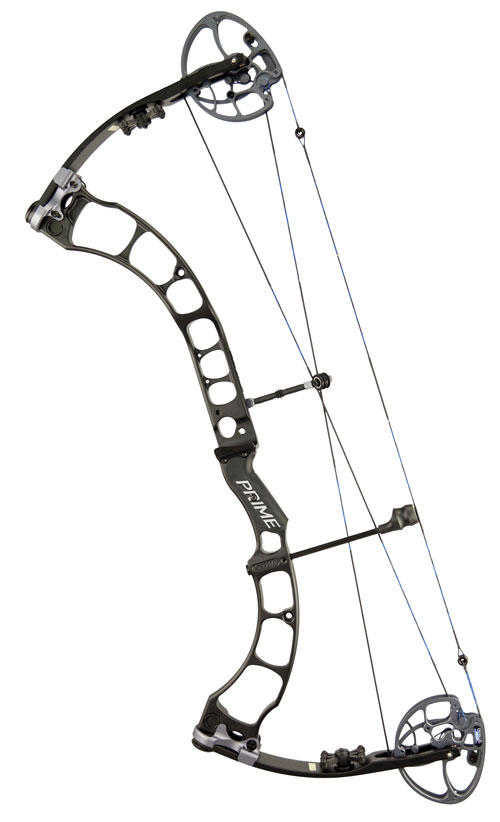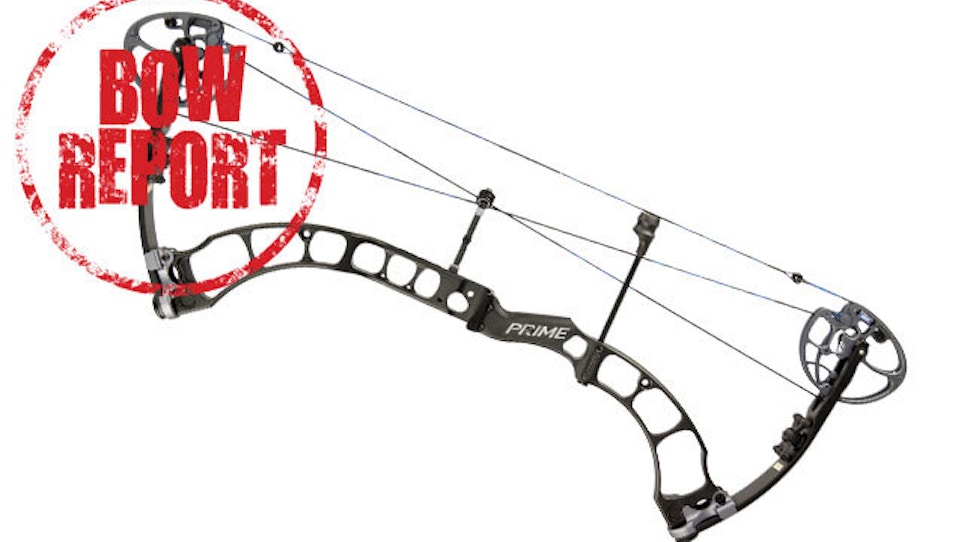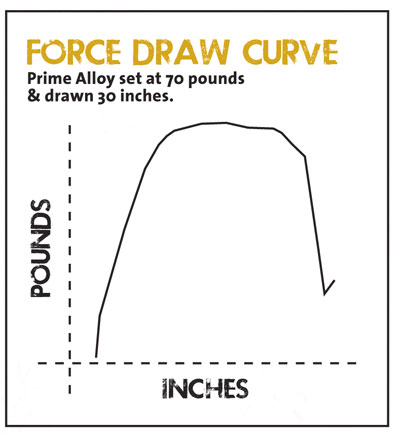When Prime’s parent company, G5, introduced its first product a few years ago, the G5 Montec broadhead made an instant impression as a product that was precisely engineered and innovative, but in a very no-frills, straightforward, get-the-job-done kind of way. Prime’s bows, including the Alloy, are consistent with that philosophy. Nothing radical about the Alloy—Prime’s Parallel cams are innovative, but the design is too obviously sensible to be considered radical. Two cams are sandwiched together at each axle, less than a half-inch apart. The string is split near each end and yoked so that one half of the split pair goes around each of the parallel cams. This design offers several advantages. To begin with, it all but eliminates cam lean. It also positions the string running straight down the vertical center of the bow, which reduces horizontal nock travel (and possibly vertical nock travel), reduces torque, and reduces any tendency for limbs to twist as the bow is drawn. Draw length is cam-specific in half-inch increments, and an adjustable limb stop allows shooters to tweak the draw length within the specified range. Shortening draw length will decrease letoff down to as much as 65 percent, while lengthening it can increase it up to 80 percent. Prime warns against shooting the bow without limb stops in place.
The name “Alloy” refers to Prime’s 7000 series aluminum alloy riser, which is stronger than the much more commonly employed T6061 aircraft grade aluminum. Prime has produced a dramatic advertisement showing an SUV being lifted into the air, suspended from a Prime bow riser. Though the material is not new, the riser design has been slightly modified for the Alloy to shave off a little weight, getting it down to 4.2 pounds—not bad at all for a 33.25-inch axle-to-axle bow.
 Also new on the Alloy is a flexing roller cable guard to reduce friction and torque. It’s adjustable, a nice design feature that allows shooters, depending on where they locate centershot and what kind of fletching they use, to move the cables in or out. Reducing torque by allowing the cable guard to flex makes sense; it makes even more sense to start out with as little cable-induced torque as possible by adjusting cable clearance to be adequate but not excessive.
Also new on the Alloy is a flexing roller cable guard to reduce friction and torque. It’s adjustable, a nice design feature that allows shooters, depending on where they locate centershot and what kind of fletching they use, to move the cables in or out. Reducing torque by allowing the cable guard to flex makes sense; it makes even more sense to start out with as little cable-induced torque as possible by adjusting cable clearance to be adequate but not excessive.
Limbs are solid, as opposed to split, complementing Prime’s approach to providing the strongest, most torque-free, most stable shooting platform possible.
The bow I tested was Jet Black—very clean without enough shine to spook game, flawless in fit and finish, and contrasting nicely with the white logo, gray cams, and blue and black 8190 BCY string and cables.
Shooting The Bow
Prime recommends 13⁄16 inch from the riser to locate centershot, with the arrow square to the string and aligned with the Berger holes or slightly higher. This provided excellent arrow flight. The riser design makes installation and adjustment of rest and sights very easy. The string stop was a half-inch from the string, requiring a simple adjustment. A set screw must be loosened before adjusting draw weight; the limb bolts were very tight, but that would be an issue only for someone inclined to change draw weight frequently.
The grip is a rubber molded grip, not overly wide. It’s very ergonomic and comfortable. It’s also removable for shooters who don’t like soft grips or who want something even narrower. I’m always a little surprised when I pick up a Prime bow. Something about the design makes it look heavier than it is, but in fact at just over 4 pounds it is reasonably light. As is the case with most compound bows, it’s slightly top-heavy. It draws smoothly, and the limb stops assure a solid back wall. At 335 fps this is a fast bow. It’s quiet, too. There is no hand shock or recoil to speak of. Without the stabilizer installed there is a slight amount of vibration; with a stabilizer, vibration is barely detectable.
At 33.25 inches axle-to-axle the Alloy is not a long bow, but it does defy slightly the trend toward increasingly compact bows. I like compact bows; on the other hand, and though not all shooters will agree, I find slightly longer bows to be more forgiving, especially at longer ranges, since shorter bows are harder not to cant. The slightly longer riser is right for a bow whose every design feature seems aimed at accuracy and shootability.
Some bows are perceived by shooters, however subjectively, as easier to shoot with accuracy than is the case for others. This bow is rock-steady at full draw and for me stacked arrows easily at 20 yards, holding tight groups out to extended ranges without requiring a great deal of concentration on perfect shooting form.
I don’t recall ever watching someone shoot a Prime bow for the first time and not grinning after a few shots. It’s also smooth enough throughout the shot cycle to be pleasant to shoot for extended periods. Though not dramatically different from its Prime predecessors, the Alloy offers several incremental improvements which, taken together, make a good bow even better and should contribute to Prime’s reputation for producing high-quality, very enjoyable-to-shoot bows.
Prime Alloy Specs
Letoff:.................................... 80%, adjustable to 65%
Brace Height:.................... 6.75 inches
Weight:................................... 4.2 pounds
Axle-To-Axle Length:. 33.25 inches
Speed:....................................... 335 fps
Draw Lengths:.................. 26 to 30 inches, cam-specific in half-inch increments.
Draw Weights:.................. 50, 60, and 70 pound peak, adjustable down 10 pounds from peak.
Options:................................ Realtree Xtra, Optifade Open Country, Optifade Forest, or Jet Black finishes.
Suggested Retail:......... $999 camo, $1,049 Jet Black
Objective Tests (30 Inches Draw)
Peak Hold*:............................ 70 pounds
Weight, Full Draw*:........... 18.0 pounds
*Rounded to nearest half-pound
At 70-Pound Draw Weight
| Arrow Weight | Speed @ Launch | Speed @ 20 Yards | K.E. @ Launch | K.E. @ 20 Yards |
| 385 grains | 314 fps | 305 fps | 85.5 ft. lbs. | 80.0 ft. lbs. |
| 500 grains | 284 fps | 278 fps | 90.0 ft. lbs. | 86.0 ft. lbs. |
At 60-Pound Draw Weight
| Arrow Weight | Speed @ Launch | Speed @ 20 Yards | K.E. @ Launch | K.E. @ 20 Yards | Sound Level |
| 385 grains | 298 fps | 290 fps | 75.0 ft. lbs. | 72.0 ft. lbs. | 57.5 dBA |
| 500 grains | 260 fps | 255 fps | 77.0 ft. lbs. | 74.0 ft. lbs. | 46.6 dBA |







